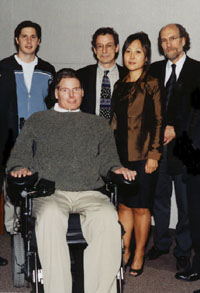
Spinal cord injury (SCI) is a devastating condition that affects about 250,000 Americans with 12,000 cases added annually. These individuals, mostly young men 16-30 years old, remain paralyzed for the rest of their lives, require continuous medical treatment and are often dependent on others. About half the injuries occur as a result of motor vehicle crashes and more than half result in tetraplegia (paralysis from the neck down). Initial costs following injury range from $200,000 to $700,000 with additional lifetime costs exceeding $2 million for the most severe injuries. The total estimated costs in PA alone are $500 million per year for just medical and supportive care with the government being responsible for over 37% of these costs. Although there are no effective treatments for SCI there is growing evidence that protection of the spinal cord from subsequent damage and promoting repair can be induced by drug therapy, transplants and rehabilitation. Promising research in SCI has also revealed that even a modest improvement will have a significant impact on quality of life and health care expenses.
More than 25 years ago, a group of faculty members at the Medical College of Pennsylvania (now the Drexel University College of Medicine) joined together to study ways of treating spinal cord injury (SCI). This group evolved into one of the premier Spinal Cord Injury (SCI) research centers in the world, with innovative and multidisciplinary programs for studying the pathophysiology of SCI and the development of therapeutic strategies to promote recovery of function. It has been recognized by Drexel University as a Center of Excellence in Spinal Cord Research, one which has taken a leading role in the use of combination therapies to address multiple aspects of spinal cord injury in preclinical applications.>
Investigators in the Center apply recent advances in stem cell transplantation, physiology of locomotion, rehabilitation protocols and pharmacological interventions to open new avenues for more effective treatments. The Center has established some of the best core facilities for SCI research to support development of innovative techniques for animal surgery, cell and molecular biology, histology and imaging, with unique strengths in behavioral and physiological analysis of motor, sensory and autonomic function.
The vision of the Center is to continue building a multidisciplinary program by including not only neuroscientists but also biomedical engineers for their insight into motor control, physical therapists for a rehabilitation perspective and a wide range of physicians to integrate clinical applications in critical disciplines such as urology (bladder function), radiology (MRI), neurology and physiatry (outcome measures), orthopedics and neurosurgery (transplantation and clinical trials). Our mission is "to bridge the gap between the discovery phase and clinical application by developing and translating promising research strategies to treat patients whose function has been limited by spinal cord injury".